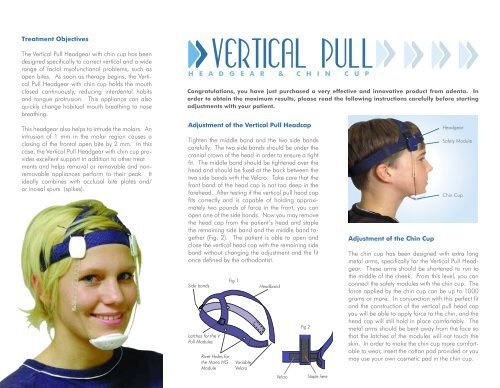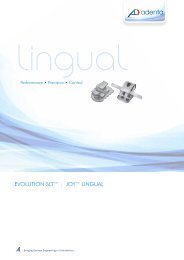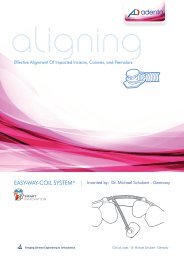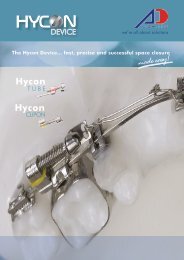Adjustment of the Chin Cup The chin cup has been ... - Adenta
Adjustment of the Chin Cup The chin cup has been ... - Adenta
Adjustment of the Chin Cup The chin cup has been ... - Adenta
Create successful ePaper yourself
Turn your PDF publications into a flip-book with our unique Google optimized e-Paper software.
Treatment Objectives<br />
<strong>The</strong> Vertical Pull Headgear with <strong>chin</strong> <strong>cup</strong> <strong>has</strong> <strong>been</strong><br />
designed specifically to correct vertical and a wide<br />
range <strong>of</strong> facial my<strong>of</strong>unctional problems, such as<br />
open bites. As soon as <strong>the</strong>rapy begins, <strong>the</strong> Vertical<br />
Pull Headgear with <strong>chin</strong> <strong>cup</strong> holds <strong>the</strong> mouth<br />
closed continuously, reducing interdental habits<br />
and tongue protrusion. This appliance can also<br />
quickly change habitual mouth breathing to nose<br />
breathing.<br />
This headgear also helps to intrude <strong>the</strong> molars. An<br />
intrusion <strong>of</strong> 1 mm in <strong>the</strong> molar region causes a<br />
closing <strong>of</strong> <strong>the</strong> frontal open bite by 2 mm. In this<br />
case, <strong>the</strong> Vertical Pull Headgear with <strong>chin</strong> <strong>cup</strong> provides<br />
excellent support in addition to o<strong>the</strong>r treat<br />
ments and helps removal or removable and nonremovable<br />
appliances perform to <strong>the</strong>ir peak. It<br />
ideally combines with occlusal bite plates and/<br />
or incisal spurs (spikes).<br />
VERTICAL PULL<br />
h e a d g e a r & c h i n c u p<br />
Congratulations, you have just purc<strong>has</strong>ed a very effective and innovative product from adenta. In<br />
order to obtain <strong>the</strong> maximum results, please read <strong>the</strong> following instructions carefully before starting<br />
adjustments with your patient.<br />
<strong>Adjustment</strong> <strong>of</strong> <strong>the</strong> Vertical Pull Headcap<br />
Tighten <strong>the</strong> middle band and <strong>the</strong> two side bands<br />
carefully. <strong>The</strong> two side bands should be under <strong>the</strong><br />
cranial crown <strong>of</strong> <strong>the</strong> head in order to ensure a tight<br />
fit. <strong>The</strong> middle band should be tightened over <strong>the</strong><br />
head and should be fixed at <strong>the</strong> back between <strong>the</strong><br />
two side bands with <strong>the</strong> Velcro. Take care that <strong>the</strong><br />
front band <strong>of</strong> <strong>the</strong> head cap is not too deep in <strong>the</strong><br />
forehead. After testing if <strong>the</strong> vertical pull head cap<br />
fits correctly and is capable <strong>of</strong> holding approximately<br />
two pounds <strong>of</strong> force in <strong>the</strong> front, you can<br />
open one <strong>of</strong> <strong>the</strong> side bands. Now you may remove<br />
<strong>the</strong> head cap from <strong>the</strong> patient’s head and staple<br />
<strong>the</strong> remaining side band and <strong>the</strong> middle band toge<strong>the</strong>r<br />
(Fig. 2). <strong>The</strong> patient is able to open and<br />
close <strong>the</strong> vertical head cap with <strong>the</strong> remaining side<br />
band without changing <strong>the</strong> adjustment and <strong>the</strong> fit<br />
once defined by <strong>the</strong> orthodontist.<br />
Side bands<br />
Latches for <strong>the</strong> V<br />
Pull Modules<br />
Rivet Holes for<br />
<strong>the</strong> Mono HG<br />
Module<br />
Fig 1<br />
Variable<br />
Velcro<br />
Headband<br />
Velcro<br />
Fig 2<br />
Staple here<br />
<strong>Adjustment</strong> <strong>of</strong> <strong>the</strong> <strong>Chin</strong> <strong>Cup</strong><br />
Headgear<br />
Safety Module<br />
<strong>Chin</strong> <strong>Cup</strong><br />
<strong>The</strong> <strong>chin</strong> <strong>cup</strong> <strong>has</strong> <strong>been</strong> designed with extra long<br />
metal arms, specifically for <strong>the</strong> Vertical Pull Headgear.<br />
<strong>The</strong>se arms should be shortened to run to<br />
<strong>the</strong> middle <strong>of</strong> <strong>the</strong> cheek. From this level, you can<br />
connect <strong>the</strong> safety modules with <strong>the</strong> <strong>chin</strong> <strong>cup</strong>. <strong>The</strong><br />
force applied by <strong>the</strong> <strong>chin</strong> <strong>cup</strong> can be up to 1000<br />
grams or more. In conjunction with this perfect fit<br />
and <strong>the</strong> construction <strong>of</strong> <strong>the</strong> vertical pull head cap<br />
you will be able to apply force to <strong>the</strong> <strong>chin</strong>, and <strong>the</strong><br />
head cap will still hold in place comfortably. <strong>The</strong><br />
metal arms should be bent away from <strong>the</strong> face so<br />
that <strong>the</strong> latches <strong>of</strong> <strong>the</strong> modules will not touch <strong>the</strong><br />
skin. In order to make <strong>the</strong> <strong>chin</strong> <strong>cup</strong> more comfortable<br />
to wear, insert <strong>the</strong> cotton pad provided or you<br />
may use your own cosmetic pad in <strong>the</strong> <strong>chin</strong> <strong>cup</strong>.
VERTICAL PULL<br />
h e a d g e a r & c h i n c u p<br />
opac technology<br />
Optimized Pressure and Air Conditioned<br />
early treatment concept<br />
University <strong>of</strong> Graz, Austria<br />
If you are using your own cosmetic pad, it is important<br />
that you fold <strong>the</strong> pad and cut out a round hole<br />
in <strong>the</strong> center, approximately 2 cm, or 8/10 <strong>of</strong> an<br />
inch. This hole will create <strong>the</strong> effect <strong>of</strong> a cushioning<br />
ring that keeps <strong>the</strong> point <strong>of</strong> <strong>the</strong> chn away from<br />
<strong>the</strong> <strong>chin</strong> cap.<br />
b e f o r e<br />
This ring shaped cotton pad distributes pressure onto<br />
a surface five times larger that <strong>the</strong> regular pressure<br />
zone at <strong>the</strong> point <strong>of</strong> <strong>the</strong> <strong>chin</strong>, and prevents uncomfortable<br />
side effects, such as skin it<strong>chin</strong>g and bacterial<br />
infections. If one pad is not enough, use two or<br />
more. Now <strong>the</strong> Vertical Pull Headgear and <strong>chin</strong> <strong>cup</strong><br />
is comfortable enough to be worn all day long.<br />
• Vertical Correction<br />
• More than 500 grams <strong>of</strong> closing force<br />
• Intrude Molars<br />
NOTE: In order to prevent abrasion <strong>of</strong> <strong>the</strong> teeth<br />
you may use a bite plate during treatment with <strong>the</strong><br />
Vertical Pull Headgear with <strong>chin</strong> <strong>cup</strong>. Very <strong>of</strong>ten<br />
<strong>the</strong> combination <strong>of</strong> <strong>the</strong> Vertical Pull <strong>chin</strong> <strong>cup</strong> and<br />
palatal spikes (bonded or banded to <strong>the</strong> palatal<br />
side <strong>of</strong> <strong>the</strong> upper front teeth) is used because <strong>the</strong><br />
Vertical Pull <strong>chin</strong> <strong>cup</strong> keeps <strong>the</strong> mouth closed and<br />
<strong>the</strong> spikes can work more effectively.<br />
<strong>The</strong> early treatment concept <strong>of</strong> 25 patients Class III<br />
(University <strong>of</strong> Graz, Austria) was developed as a result<br />
<strong>of</strong> a long term study that early start <strong>of</strong> treatment at an<br />
age <strong>of</strong> 3-6 Years is very important. <strong>The</strong> Vertical Pull<br />
Headgear and <strong>chin</strong> <strong>cup</strong> should be worn 24 hours/day<br />
until a little Class II overcorrection is reached. Depending<br />
on <strong>the</strong> growth <strong>of</strong> <strong>the</strong> bone later on, it could<br />
be necessary that <strong>the</strong> appliance must be worn for a<br />
fur<strong>the</strong>r period <strong>of</strong> time. <strong>The</strong> results <strong>of</strong> <strong>the</strong> long-term<br />
study over <strong>the</strong> ETC shows that a significant reduction<br />
<strong>of</strong> <strong>the</strong> Gonion-angle was reached compared to <strong>the</strong><br />
non-treated Class I referring group. <strong>The</strong> reduction<br />
was in average 9.3° from 129.8° to 120.5°.<br />
If you have patients with long hair, it is important to<br />
suggest that <strong>the</strong>y wear <strong>the</strong>ir hair over <strong>the</strong> headgear<br />
(pigtails or braids) as opposed to putting <strong>the</strong>ir hair<br />
under <strong>the</strong> headgear. This is crucial to <strong>the</strong> holding<br />
power <strong>of</strong> <strong>the</strong> Vertical Pull Headgear Cap.<br />
phone: 1-215-942-2070 - Toll free: 1-888-942-2070<br />
email: info@adentausa.com - website: www.adentausa.com









